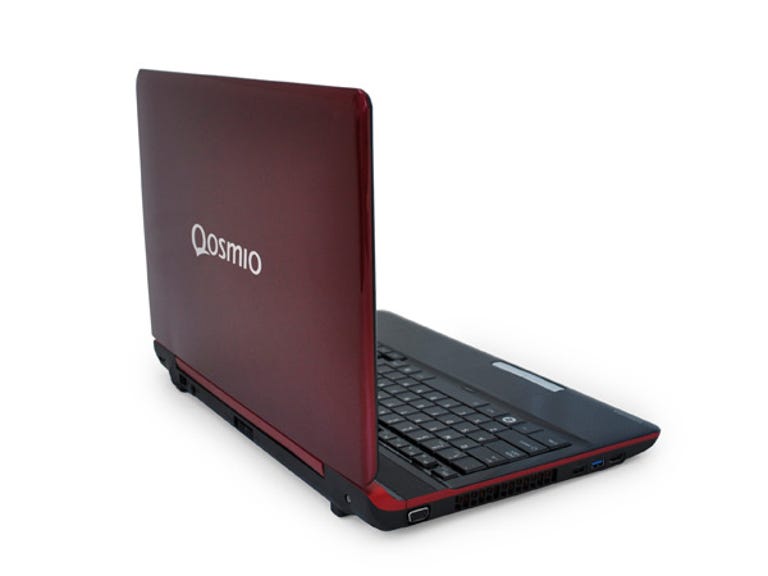 Why You Can Trust CNET
Why You Can Trust CNET Toshiba Qosmio F750 review: Toshiba Qosmio F750
The latest in Toshiba's Qosmio line is an entertainment-heavy beast. And we do mean heavy.
Design
Toshiba doesn't tend to muck about with its Qosmio lines. They're the top of the pile from Toshiba, decked out with everything that the company can think of including in a multimedia notebook, and then usually a few extra gadgets again. Toshiba's Qosmio F750 is no exception.
The Good
The Bad
The Bottom Line
All of that visual goodness has a price attached to it, but it's not entirely one that's borne out by how much lighter your wallet will be. At AU$1699, the Qosmio F750 feels like reasonable value, at least on paper, but the real weight will come if you ever did choose to move it around. At 387.6x266.8x34.8mm and 2.8kg, this is a serious chunk of notebook, and one that'll quickly drag your shoulder to the ground if you carry it around for any notable length of time.
That kind of space does afford Toshiba the luxury of a full-sized keyboard, including number pad and full-sized cursor keys, as well as a touch-sensitive area for Wi-Fi, volume and playback controls, Harman/Kardon speakers built in above the keyboard and a 15.6-inch display screen. The F750's interior is all black with a slight chequered pattern under the wrist rest, while the outside body is a dark, lustrous red. Or, to put it another way, if you did possess the strength to carry this notebook out and about, you'd probably get mugged, because it does indeed look like serious money.
Features
Speaking of all things serious, Toshiba's also not mucking around when it comes to internal components. The F750 comes with an Intel Core i7 2630QM 2Ghz CPU, 750GB hard drive, Nvidia GeForce GT 540M and 8GB of internal RAM. The only catch with the RAM is that both RAM slots are occupied, and the maximum RAM tops out at 8GB; out of the box, this is as good as the F750's going to get.
Toshiba's marketing materials describe the Qosmio F750 as a "deluxe HD notebook", but there's a very slight bit of obfuscation going on here. It's good that they didn't slip the word "full" in front of "HD" there, because with a display resolution of 1366x768, the one thing that this Blu-ray-capable notebook can't do is full HD 1080p display.
One thing that it can do is 3D — of a sort. Throw a 3D-capable Blu-ray disc into the F750, and it'll output it via HDMI to a 3D-capable screen. Models of the Qosmio F750 sold outside of Australia appear to be capable of on-display 3D via a lenticular lens built into the screen of the F750, but the model supplied to CNET Australia lacked that functionality; all that happened when we played back 3D content (or up-scaled 3D content) directly on the F750 was a split-screen dual image like you'd get when trying to watch 3D content on a regular screen.
The F750 is Blu-ray capable, as well as equipped with VGA, HDMI, 3 USB 2.0 ports (capable of sleep-charging external devices) and a single USB 3.0 port, SD card reader, coaxial input for digital/analog TV services, Gigabit Ethernet and 802.11n Wi-Fi. On the software side, it's running Windows 7 Home Premium 64-bit, and is relatively light on the software front, with only trial versions of Norton Internet Security 2010 and Microsoft Office Starter Edition pre-installed alongside specific Toshiba utilities.
Performance
We were initially a little concerned about the lack of Full HD clarity on the Qosmio F750's display screen, but for a screen this size and quality, there's really very little to worry about, as the distinction quickly blurs out unless you sit nose to screen. We wouldn't advise you do that, and we feel confident that your optician would back us up on that. The combination of a decent processor and a good quantity of memory helped the Qosmio F750 to a solid set of benchmark scores, landing 8187 in PCMark05 and 9219 in 3DMark06. We've certainly seen better from some notebooks, but these are solid scores indicating that it should handle most multimedia tasks well, although the lower-resolution display would make it a slightly less-than-optimal games machine.
At this size and weight, we weren't expecting great things out of the Qosmio F750's battery, and it's a good thing that we went in feeling pessimistic. Even Toshiba doesn't talk up this particular aspect, suggesting that it's only capable of "up to" three and a half hours of battery performance. Using our standard battery test metrics, disabling all battery-saving measures and putting screen brightness up to full, the F750 managed a meagre two hours and 15 minutes exactly in video playback. You should manage more in a less-punishing environment, but probably not much. In case it hasn't sunk in yet: this is a desktop replacement-style multimedia notebook, not a MacBook Air.
Conclusion
The Qosmio F750 clearly isn't a notebook for everybody; if you want thin and light or long battery life, especially, it's not for you. However, those looking for a notebook that could serve as their entire home theatre experience with the flexibility of external 3D output would be well served by it.


